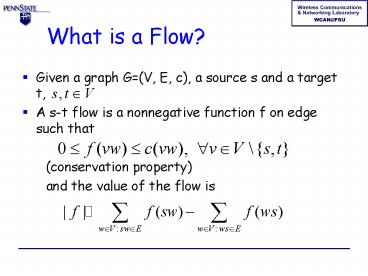What is a Flow PowerPoint PPT Presentation
Title: What is a Flow
1
What is a Flow?
- Given a graph G(V, E, c), a source s and a
target t, - A s-t flow is a nonnegative function f on edge
such that - (conservation property)
- and the value of the flow is
2
What is the Max of Flows?
- Subgraph G(V, E, c)
- V, E are subsets of V and E respectively
- Suppose a s-t flow is ft , the max of flows is a
subgraph
3
Sum of Max of Flows
- Superimposing communication is a suboptimal
- Need cross session network coding to achieve the
optimality - However, superimposing communication is still a
viable way to the multisession multicast
communication - Moreover, superimposing communication problem can
be easily transformed into a linear programming
4
Sum of Max of Flows(2)
- Capacity graph G(V, E, c)
- Multicast sessions
- By sharing bit-rate resources to sessions, we can
form following equalities and inequalites
5
Cross-layer Optimization
- Capacity graph is spanned by a set of ECGs
- Different ECGs can support different capacity
graph - Practically, we can not find all the ECGs due to
the large number of nodes in the network - We can only choose a set of ECGs to span a
reasonable good capacity graph
6
Cross-layer Optimization(2)
- Objective
- Given a set of traffic demands
we pick up a set of ECGs and
corresponding timesharing factor , therefore,
we get the capacity graph such
that it supplies U and minimizes a desired cost
function
7
Cost function-Bandwidth
- Given a set of ECGs B
- V physical nodes virtual nodes
- E physical links links between physical
nodes and virtual nodes - timesharing factors
- Fixed B, max rate scaling factor alpha w.r.t. the
variables timesharing factor and flows
8
Cost function-Bandwidth
- The linear programming is formulated as
9
Cost function-Bandwidth
- We can also rewrite the linear programming as
10
Cost function-Bandwidth
- Note that there is no constraint that the sum of
the timesharing factor is no more than 1 in the
rewritten linear programming - With increasing, the traffic load will also
increase. It is possible that it comes to a point
that congestion occurs. - Define aggregate congestion measure
11
Cost function-Energy
- If the total power consumption for ECG ,
then the linear programming for minimizing the
total power can be formulated as
PowerShow.com is a leading presentation sharing website. It has millions of presentations already uploaded and available with 1,000s more being uploaded by its users every day. Whatever your area of interest, here you’ll be able to find and view presentations you’ll love and possibly download. And, best of all, it is completely free and easy to use.
You might even have a presentation you’d like to share with others. If so, just upload it to PowerShow.com. We’ll convert it to an HTML5 slideshow that includes all the media types you’ve already added: audio, video, music, pictures, animations and transition effects. Then you can share it with your target audience as well as PowerShow.com’s millions of monthly visitors. And, again, it’s all free.
About the Developers
PowerShow.com is brought to you by CrystalGraphics, the award-winning developer and market-leading publisher of rich-media enhancement products for presentations. Our product offerings include millions of PowerPoint templates, diagrams, animated 3D characters and more.

